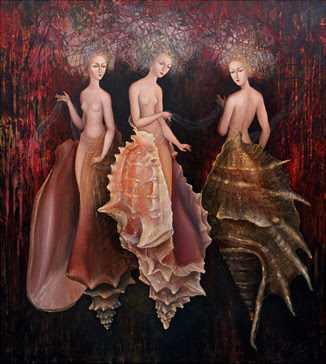Labels such as fantastic art, visionary art, magic realism art, psychedelic art and dark surreal art are applied to categorize the surreal artists of the present day, who were highly influenced by the original group of the Surrealist Movement.
I will present the usual assortment of the contemporaries but for a bit, I have a brief history of Dada (the root movement) and Surrealism.
I will present the usual assortment of the contemporaries but for a bit, I have a brief history of Dada (the root movement) and Surrealism.
The Surrealist movement, founded by writer and poet Andre Breton, was established in the early 20's. It was born out of the World War I movement of Dada. Literature, poetry, art theater and art theory were all connected around manifestos and radical political and social thinking, including anarchy.
Abstract art, sound poetry and performance artists today own and often homage to to Dada. The dadaists rejected conventional social thought and aesthetics, preferring to shock and offend people; all in an effort to liberate the proletariat from the clutches of the capitalist, fascist state.
 Later, Salvador Dali stated:
Later, Salvador Dali stated: "There is only one difference between a madman and me. I am not mad."
His assertion was, in fact, confirmed by Sigmund Freud, another famous founding father whose ideas contributed greatly to the social, intellectual and artistic circles of the time.
The Surrealists were attracted to Freud's ideas because one of their goals was to channel the unconscious as a means to unlock the power of the imagination.
Dali met Freud in London in 1938. At that meeting, Dali showed Freud his 1937 work Metamorfosis de Narciso. Freud was not found of the Surrealist movement but made an exception where Dali was concerned. The work of Joseph Cornell (1903–1972) and Arshile Gorky (1904–1948) was to be heavily influenced by the Surrealist and was a sort of bridge between surrealism and abstract expressionism.
"Up to now I have been inclined to consider surrealists, who seem to have chosen me as their patron saint, as incurable nutcases. The young Spaniard, however, with his candid, fanatical eyes and unquestionable technical skill has made me reconsider my opinion. In fact, it would be very interesting to investigate the way in which such a painting has been composed."
- Sigmund Freud
Dada
 |
| Hannah Hoch |
 |
| Andre Breton, author of the Surrealist Manifesto |
"Living and ceasing to live that are imaginary solutions. Existence is elsewhere.''
Selected Works of Contemporary Art, influenced by Surrealism
(I've attempted to provide attribution and links to the artist site whenever possible)
 |
| Ronald Companoa |



























Dada wouldn't buy me a Bauhaus. :-)
ReplyDeleteFor those of you not familiar (and I just spent the last half hour reading about Bauhaus myself and not yet done): Thanks, Francis. :-)
ReplyDeleteBauhaus</
art frees the mind and heart and soul
ReplyDeleteI love all the work you put into these posts
it's like a Sunday morning visit to the museum
I will have to create a post just for Hope. I will write you and find out what she likes. :-) xxoo
ReplyDeleteAnother great selection Gina Thanks!
ReplyDeleteI can't imagine anyone hating Salvadore Dali's work but I can understand a preference for less disconcerting images if you're redecorating the living room. (Imagine what Giger's home furnishings look like.)
ReplyDeleteOf the modern work you've posted, naturally enough, some appeal more than others simply from a reinforcing pleasant visions point of view. Yes, that's shallow and I understand Dadaism was meant to 'afflict the comfortable'.
I like the Vladimir Kush painting for it's whimsy in a darkening landscape. I've always seen that as an appealing way of looking at the world.
The Ronald Companoa piece has some strong fantasy elements that remind me of Steve Emery's wonderful paintings.
Martin Hoffman's visionary piece is fascinating in its multiple levels of possible meanings.
Oh dear, is Anne Siems making a statement about the fleeting nature of childhood here or simply the fact that nothing lasts long?
Carlos Huentes held my attention longer than the others but I'm opting for the "Still Life With Fruit' for the dining room over this.
Nicoketta Ceccoli paints a very strange sort of innocence, doesn't she?
They're all interesting in their own ways but the last one I like enough to mention is the painting by Daniela Ovtcharov. The delicacy of her shell-dressed ladies is very lovely.
Thanks for taking the time to choose such a nice collection, Gina.
Superb and edifying post.
ReplyDeleteCompanoa = Breughel on LSD
ReplyDeleteHave a Great Week
Aloha from Honolulu
Comfort Spiral
=^..^=
> < } } ( ° >
Lots of helpful information. I have bookmarked your site.
ReplyDeleteThis was an engaging set. I was viewing it with oldest, who is on the way to being a professional artist (designer/illustrator) and we got off on an hour or so of tangents tracking down more of Kandl, Ceccoli, and Companoa. We got so busy I forgot to comment!
ReplyDeleteHuentes made us shudder - I echo Susan's sentiments. The Kush got "Ahh"s from both of us. Elegant, simple concept (often the best work is). And what drew us both in was the Dali human skull. Wow. The man had a brilliant imagination - and he heard/saw it to an amazing degree.